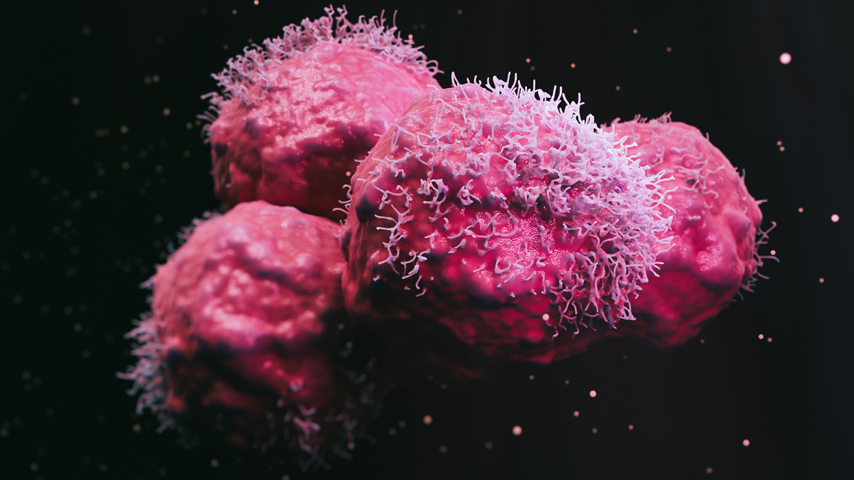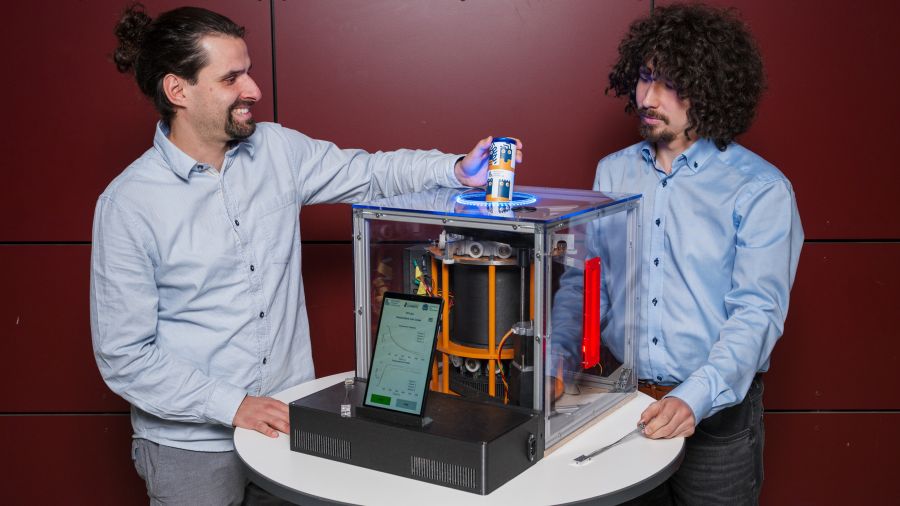Discovery of New Plasma-Enabled Process Offers Promise
Discovery of New Plasma-Enabled Process Offers Promise


Anchoring nanoparticles directly onto substrates shows promise in biomedical and other disciplines.
A new plasma-enabled process that deposits nanoparticles directly onto substrates shows promise for other applications. Last year, researchers at the University of Alabama Birmingham announced the development of a plasma electroless reduction (PER) technique to help limit the proliferation of toxins from implants into a patient’s bloodstream.
That team’s work, led by Vinoy Thomas, associate professor in the UAB School of Engineering’s Department of Mechanical and Materials Engineering, involved the generation of gold and silver nanostructures deposited onto different 2D and 3D polymer material surfaces. This PER process stably attached metallic nanoparticles onto materials such as cellulose paper, polypropylene-based facemasks or 3D printed polymer scaffolds. The development is important because previously established synthesis techniques that used aqueous solutions can create toxicity issues due to rapid and premature release of metallic nanostructures into the bloodstream.
Plasma, the fourth state of matter, unlike liquids, solids and gas, does not naturally exist on Earth, but can be created by heating neutral gases. The PER process, which took two years to develop, was documented in the ACS Applied Materials & Interfaces Journal. Now, ongoing research using the technique is showing promise for many other applications.
“In this process, we are directly anchoring nanoparticles onto the substrate,” Thomas said, likening the process to ice crystals forming on a window.
Become a Member: How to Join ASME
The plasma-enabled process research is one aspect of several projects part of a program called the EPSCoR Research Infrastructure Improvement Program. It’s supported by a five-year, $20-million grant funded by the National Science Foundation. The program involves nine universities, including UAB, is managed by the University of Alabama Huntsville (UAH), and includes support from private business interests.
Thomas and his team, along with other researchers in the program, are interested in expanding PER’s capabilities by using it in other applications. One of Thomas’ current studies includes using PER to modify the inner surfaces of vascular and hemodialysis access grafts to improve blood flow and compatibility.
“The hemodialysis patient has to attach his blood drawn from a graft,” Thomas explained. “We are modifying the inner surface using this plasma processing now, and we implanted these modified grafts in a pig model already.”
He added UAB recently received another grant from the Alabama Department of Commerce to see if PER can be transitioned for use in creating metallic stents, which is in the preliminary stages of study.
“Whatever the property you need, you can have that property onto the nanoparticles that can be processed the uniformly onto the substrate,” Thomas said, emphasizing it’s “not a coating. We are synthesizing in situ on to the substrate.”
That has implications beyond biomedical applications. Thomas offered other examples such as integrating antibacterial properties onto touchscreens such as those on a cell phone or tablet, which can collect bacteria on the surface when handled.
More for You: Smart Coatings on Implants Transmit Health Data in Real Time
“We can have a uniform layer of nanoparticle on the glass surface,” Thomas said. “These nanoparticles may have antibacterial properties.”
While Thomas’ team in the mechanical and materials engineering department is more focused on biomedical materials and soft polymers, his colleagues in UAB’s physics department are studying PER’s application primarily for hard coatings, such as materials used in the auto and space industries.
[This is where some of the first exploration of plasma-enabled processes began. “In space, 99% of the matter is plasma…so they were thinking about plasma a long, long way back.” Thomas said. “There are a lot of things people think of where we can apply [it], because this instance is not substrate dependent…it can be applied to any surface.
“Our future interest is to apply this to even biological materials, even proteins. People are thinking you can use plasma to kill tumors,” Thomas said, noting it may be applicable to surface tumors such as skin cancers.
The ability to use plasma to exfoliate single layers also offers promise to converting graphite into graphene, which is of interest to Silicon Valley chipmakers.
A benefit of the PER process, whatever the eventual application, is that it’s greener than other methods.
“In our technique, there is no purification…because we are not using any harsh organic solvents,” he said. “You are creating everything from a gaseous state.” He says the gases they use, such as argon or helium, are not reactive, eliminating the need for post-processing.
Editor's Pick: Nano Recall
The overall goal of these collective efforts is to improve the economic growth of Alabama and fill the talent pipeline with those who understand how plasma-enabled applications can help advance industry. Thomas believes there is tremendous growth in the study and practice of plasma medicine and also noted the growing fields of plasma diagnostics, modeling and physics.
The team has already applied for patents on some of the techniques developed and if approved, will expect more interest from established private companies or even the generation of new startup companies that can bring the technique to market.
Thomas also developed a materials engineering course on plasma processing of materials, first offered at UAB last fall, which he expects to continue to teach.
Nancy Kristof is an independent writer in Denver.

That team’s work, led by Vinoy Thomas, associate professor in the UAB School of Engineering’s Department of Mechanical and Materials Engineering, involved the generation of gold and silver nanostructures deposited onto different 2D and 3D polymer material surfaces. This PER process stably attached metallic nanoparticles onto materials such as cellulose paper, polypropylene-based facemasks or 3D printed polymer scaffolds. The development is important because previously established synthesis techniques that used aqueous solutions can create toxicity issues due to rapid and premature release of metallic nanostructures into the bloodstream.
Plasma, the fourth state of matter, unlike liquids, solids and gas, does not naturally exist on Earth, but can be created by heating neutral gases. The PER process, which took two years to develop, was documented in the ACS Applied Materials & Interfaces Journal. Now, ongoing research using the technique is showing promise for many other applications.
“In this process, we are directly anchoring nanoparticles onto the substrate,” Thomas said, likening the process to ice crystals forming on a window.
Become a Member: How to Join ASME
The plasma-enabled process research is one aspect of several projects part of a program called the EPSCoR Research Infrastructure Improvement Program. It’s supported by a five-year, $20-million grant funded by the National Science Foundation. The program involves nine universities, including UAB, is managed by the University of Alabama Huntsville (UAH), and includes support from private business interests.
Thomas and his team, along with other researchers in the program, are interested in expanding PER’s capabilities by using it in other applications. One of Thomas’ current studies includes using PER to modify the inner surfaces of vascular and hemodialysis access grafts to improve blood flow and compatibility.
“The hemodialysis patient has to attach his blood drawn from a graft,” Thomas explained. “We are modifying the inner surface using this plasma processing now, and we implanted these modified grafts in a pig model already.”
He added UAB recently received another grant from the Alabama Department of Commerce to see if PER can be transitioned for use in creating metallic stents, which is in the preliminary stages of study.
“Whatever the property you need, you can have that property onto the nanoparticles that can be processed the uniformly onto the substrate,” Thomas said, emphasizing it’s “not a coating. We are synthesizing in situ on to the substrate.”
That has implications beyond biomedical applications. Thomas offered other examples such as integrating antibacterial properties onto touchscreens such as those on a cell phone or tablet, which can collect bacteria on the surface when handled.
More for You: Smart Coatings on Implants Transmit Health Data in Real Time
“We can have a uniform layer of nanoparticle on the glass surface,” Thomas said. “These nanoparticles may have antibacterial properties.”
While Thomas’ team in the mechanical and materials engineering department is more focused on biomedical materials and soft polymers, his colleagues in UAB’s physics department are studying PER’s application primarily for hard coatings, such as materials used in the auto and space industries.
[This is where some of the first exploration of plasma-enabled processes began. “In space, 99% of the matter is plasma…so they were thinking about plasma a long, long way back.” Thomas said. “There are a lot of things people think of where we can apply [it], because this instance is not substrate dependent…it can be applied to any surface.
“Our future interest is to apply this to even biological materials, even proteins. People are thinking you can use plasma to kill tumors,” Thomas said, noting it may be applicable to surface tumors such as skin cancers.
The ability to use plasma to exfoliate single layers also offers promise to converting graphite into graphene, which is of interest to Silicon Valley chipmakers.
A benefit of the PER process, whatever the eventual application, is that it’s greener than other methods.
“In our technique, there is no purification…because we are not using any harsh organic solvents,” he said. “You are creating everything from a gaseous state.” He says the gases they use, such as argon or helium, are not reactive, eliminating the need for post-processing.
Editor's Pick: Nano Recall
The overall goal of these collective efforts is to improve the economic growth of Alabama and fill the talent pipeline with those who understand how plasma-enabled applications can help advance industry. Thomas believes there is tremendous growth in the study and practice of plasma medicine and also noted the growing fields of plasma diagnostics, modeling and physics.
The team has already applied for patents on some of the techniques developed and if approved, will expect more interest from established private companies or even the generation of new startup companies that can bring the technique to market.
Thomas also developed a materials engineering course on plasma processing of materials, first offered at UAB last fall, which he expects to continue to teach.
Nancy Kristof is an independent writer in Denver.

Pulse of the Profession: Design for Manufacturing
Design for manufacturing brings manufacturing engineering into the design process from the start.






